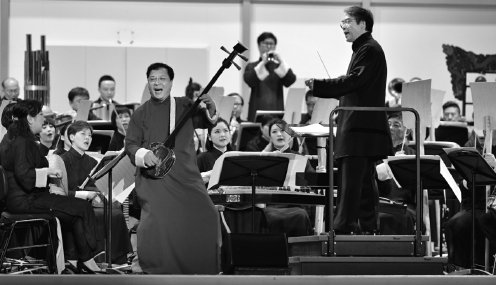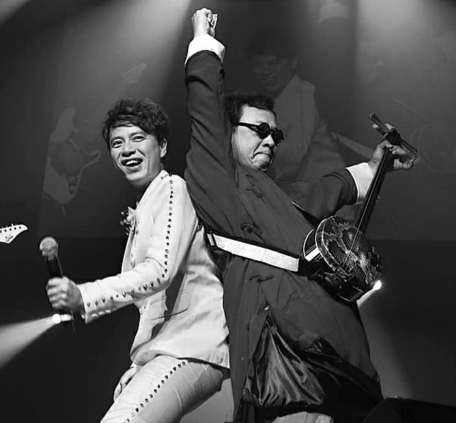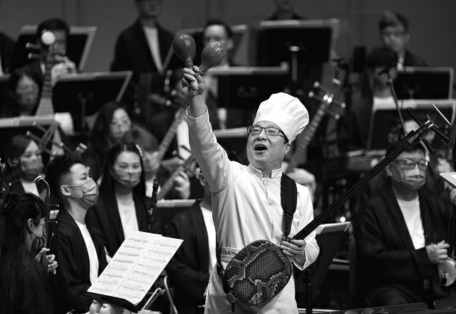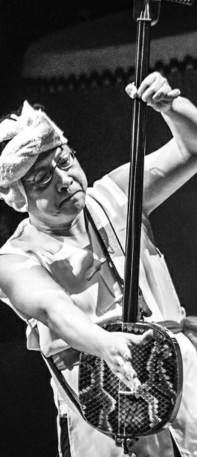The sound of our history
Zhao Taisheng has a mission to keep the traditional instrument, sanxian, alive, Xu Weiwei reports in Hong Kong.

Musician Zhao Taisheng calls his favored instrument — the sanxian, or three-stringed lute — a voice for his emotions, a vehicle for charm and honor, and a ticket to an eventful life.
Zhao is the principal sanxian player in the Hong Kong Chinese Orchestra (HKCO), and has devoted his career to perfecting his skill on the instrument and preserving this ancient art. He regards the sanxian as an important part of Chinese folk music tradition and warns against its contemporary marginalization.
Like most folk traditions, it is difficult to trace the origins of the sanxian. By some accounts, it may date back to the Qin Dynasty (221-206 BC). Images of similar instruments can be found in a Southern Song Dynasty (1127-1279) sculpture, and the characters sanxian, which literally mean "three strings", first appeared in a Ming Dynasty (1368-1644) text.
The sanxian has a striking appearance: a long, thin neck attached to a small, rounded sound box covered with snake skin. It is usually around 120 centimeters long, and has three strings stretched over a fingerboard, which allows for extensive glissando, or the glide from one pitch to another.
It has a dry, loud, percussive sound — clear, powerful, sonorous and expressive. "The sanxian is the'guts' of a Chinese folk music band," Zhao says.
He explains that, in the early decades of the 20th century, the number of students of the sanxian was similar to that of those studying other traditional Chinese string instruments such as the pipa or guzheng. However, the instrument began to lose popularity with the adoption of Western orchestral styles, which preferred softer harmonies.
For Zhao, however, the lure of the sanxian is timeless, and as the country's tastes are swiveling back toward traditional forms, he and his ancient instrument are increasingly in the spotlight.
In 2011, Zhao was invited to appear as a guest performer at a concert held at the Hung Hom Coliseum by famous Hong Kong pop star Hacken Lee. His solo sanxian part was gobbled up by audiences.
"We played seven shows in a row. In every show, the audience would explode when I started to play," Zhao recalled. "They were going nuts for the sanxian."
According to Zhao, some listeners could not believe such a powerful sound could come from an acoustic instrument. After one performance, a renowned composer told him backstage that he thought Zhao was only miming to a hidden electric guitar.
Zhao's lectures on the sanxian and the history and culture surrounding it have been received with almost as much fervor as his performances. He delivered two on the same day at the Shanghai Conservatory of Music in 2019. "For the second one, the place was packed," he recalls.
Though his success now is undeniable, Zhao's early career was far from smooth. He failed the entrance exam twice before finally passing to enroll as a student in the traditional Chinese instruments department at the Central Conservatory of Music in Beijing.
He was born into a salt-of-the-earth family in Qiaoli town, North China's Shanxi province. His father practiced traditional Chinese medicine and his mother was a rural housewife.
"No one in my family had any musical background," he says. "But they were unconditionally supportive of me learning music, especially my mom."
His introduction to the instrument came in primary school, when he joined a student band. After his peers grabbed the more popular instruments such as the guzheng or erhu, he found that only one was left: a long, strange gadget lying against the wall. "I thought it actually looked pretty cool, so I picked it up," he says.
He mostly had to learn the instrument by himself. The more praise he won for his performances, the harder he practiced. His interest in and love for the sanxian grew out of this childhood experience.
After graduation, Zhao joined the Beijing Performance and Arts Group, where he would give solo performances on weekends before a reshuffle in the company. He eventually left to pursue a series of non-music related ventures, such as running restaurants; but his passion for the sanxian never waned.
In 2005, Zhao joined the HKCO, and has served as the principal sanxian performer since 2017. While on tour with the orchestra in countries as Russia, Singapore and Estonia, his solo performance of the Song of Black Earth, in which he sang over his own lute playing, has earned him standing ovations.
Zhao is concerned about the survival of his ancient art, as many professional orchestras lack the instrument. In order to revive interest in it, he and the HKCO have arranged to celebrate the Chinese New Year by debuting their newest sanxian production, As the Strong Winds Blow. One show took place on Friday, with the other set for Saturday night at the Hong Kong City Hall.
"At these two concerts, we are making a bold attempt," he says. "All five of the works performed are large concertos that combine music from various parts of China."
The orchestra's artistic director Yan Huichang wrote a song for the show named Nuo, or exorcism dance, representing southern China. Northeast China is represented by the Song of Black Earth. The northern style is represented by Strings and Drum in Harmony. Zhao, to provide a taste of northwestern music, has chosen to combine in his piece northern Shaanxi monologue storytelling with an auxiliary rhythm beater tied to his leg. Local composer Ng Cheuk-yin has also contributed a performance.
"We can say that the concerts cover all the major components of traditional Chinese music culture," Zhao says.
Zhao has been greatly encouraged by all the support and interest he and his sanxian have garnered, and vows to continue striving to keep the instrument a living part of Chinese culture.
"I have countless memories of my performances being well-received, and these experiences have encouraged me to work harder to carry the art of the sanxian forward," he says.




Today's Top News
- China ranks among top 3 trading partners for 157 countries, regions: official
- Restoring truth is the least we can do to serve history
- Israeli airstrikes hit Gaza amid worsening humanitarian crisis
- Book on Confucianism launched in Brussels
- Right track for China-ROK ties lauded
- Nursery rooms help fathers take part in parenting duties with more ease































